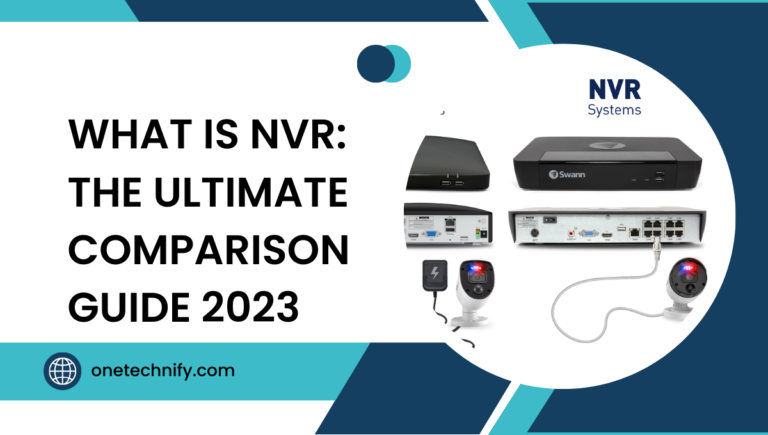OSP fiber is an important part of modern communications. Skilled fiber techs install and maintain this equipment to ensure reliable connections. Unlike copper cables, OSP fiber cables can transmit a lot of data over long distances without losing signal. FiberTechs have made a big impact by creating a solution that can handle many fibers at once. This helps expand telecommunication infrastructure and meet the needs of communication systems. If you want fast and reliable communication networks, OSP fiber is the way to go. Our fiber techs specialize in installing and maintaining communication systems, so get ready for a project where speed, reliability, and distance matter.
Table of Contents
Basics of OSP Fiber Optic Cables: Role in Outside Plant Networks
OSP fiber optic cables, also known as cabling, are a crucial component of outside plant networks, providing reliable and efficient connectivity between different locations. Fibertechs install and maintain cables for communication equipment. These cables are made specifically for outdoor use and can handle tough conditions. They are important for a reliable fiber optic network. The cables have three main parts: the core, cladding, and protective sheath. The core carries the light signals, while the cladding prevents signal loss. The protective sheath protects the cables and connectors from things like moisture and temperature changes. In outside networks, these cables connect buildings, homes, cell towers, and offices. Connectors and splices help with high-speed data transfer over long distances.
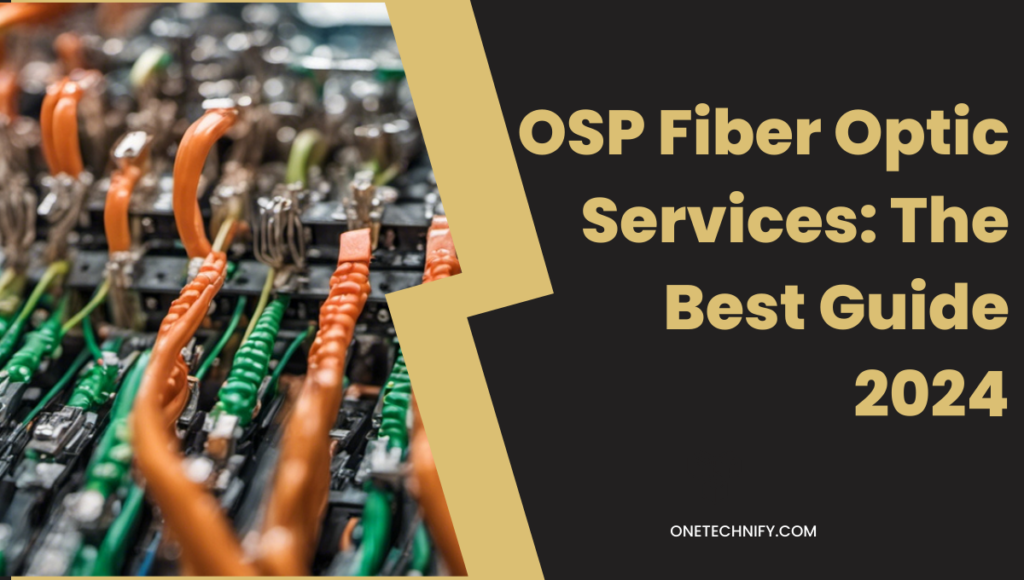
Here are some key points about OSP fiber optic cables, cabling, splices, and connectors, in outside plant networks for communications.
- Connectivity: OSP fiber optic cabling enables seamless connectivity between different premises applications and network elements. The cabling ensures efficient communication and reliable transmission of data, thanks to its advanced technology. Additionally, it allows for easy installation and maintenance of communication equipment. Furthermore, the cabling supports secure and efficient splices, ensuring optimal performance of the network.
- Versatility: These cabling can be installed underground or overhead on poles to suit different deployment scenarios. The splices and equipment used in the installation process ensure seamless connectivity.
- Reliability: OSP fiber optic cabling provides high reliability with minimal signal loss over long distances, ensuring efficient communications. The cables are equipped with splices to enhance their performance and connect various equipment seamlessly.
- Scalability: They offer scalability options for future cabling, systems, communications, and equipment network expansion and upgrades.
- Durability: Designed to withstand extreme weather conditions and physical stressors, our equipment and hardware are built to last, making them ideal for work both inside and outside.
- Flexibility: Can be easily spliced or terminated to accommodate changing cabling, fiber optic cable plant, communications, and link network requirements.
OSP Fiber Optic Network Design: Overview and Connectivity Options
To ensure optimal performance, scalability, and flexibility for future expansion, the design of an OSP fiber optic network involves careful planning of cabling routes, selection of appropriate cable types, and determination of communications connectivity options. Depending on specific requirements, different connectivity options for cabling can be utilized, including point-to-point connections, ring topologies, or star configurations. Fiber optic cable is commonly used in communications to establish a reliable link.
Planning the Routes
When designing an OSP fiber optic network, it is crucial to plan the routes effectively to ensure efficient cabling and a well-organized cable plant for seamless communications systems. This involves identifying the locations where the cabling and cable plant for communications will be installed and determining the most efficient paths to connect various network equipment and communication systems. By carefully considering factors such as existing cabling infrastructure, terrain conditions, and potential obstacles like buildings or roads, a well-designed route for communications systems work can be established.
Selecting Cable Types
Choosing the right cables is important for a fiber optic network. Different cables have different capabilities. For shorter distances, use multimode fiber cables. For longer distances, use single-mode fibers. It is also important to document the cables and equipment for troubleshooting. A strong link between network components is needed for good communication. Cost and future-proofing are also important factors to consider when choosing cables.
Determining Connectivity Options
Connectivity options are important for communication in a fiber optic network. Point-to-point connections link two endpoints directly. Ring topologies connect multiple fibers in a circle to have backup paths. Star configurations use a central hub to connect multiple fibers. It’s crucial to document these systems for maintenance and troubleshooting. Designers can create strong systems by thinking about connectivity options during the design phase.
OSP Fiber Optic Installation: Step-by-Step Guide
To ensure a successful OSP (Outside Plant) fiber optic installation project, several key steps must be followed. These steps involve the proper handling and installation of cables, equipment, and systems. Let’s dive into each of these steps in detail:
Site Preparation
Before beginning the installation of the equipment for the project, proper site preparation is crucial. This includes ensuring the systems and cable plant are ready for installation. This involves assessing the job site and ensuring it meets the requirements for equipment installation, project design, and laying fiber optic cables. Whether it’s trenching or aerial deployment, the site must be ready for the installation of equipment and systems to accommodate the cables for the project.
Cable Installation
Once the site is prepared, it’s time to lay down the fiber optic cables for the equipment installation project at the plant. Whether you’re working on a cable plant project or designing equipment, splicing or connectorization techniques are used to join individual fibers together or terminate them respectively. Whether you’re working with single-mode or multi-mode fibers, these techniques are essential.
Testing and Documentation
After the installation of the cables is completed, thorough testing is essential to verify their integrity before connecting them to active equipment in the project. This ensures that the design and plant of the project are functioning properly. This includes checking the equipment for any signal loss or disruptions during the installation project. Additionally, it involves ensuring that the cable design is suitable for the intended purpose and length. Proper documentation of all cable plant installations, equipment, fiber counts, and project design is necessary for future reference and troubleshooting purposes.
Patch Panel Installation
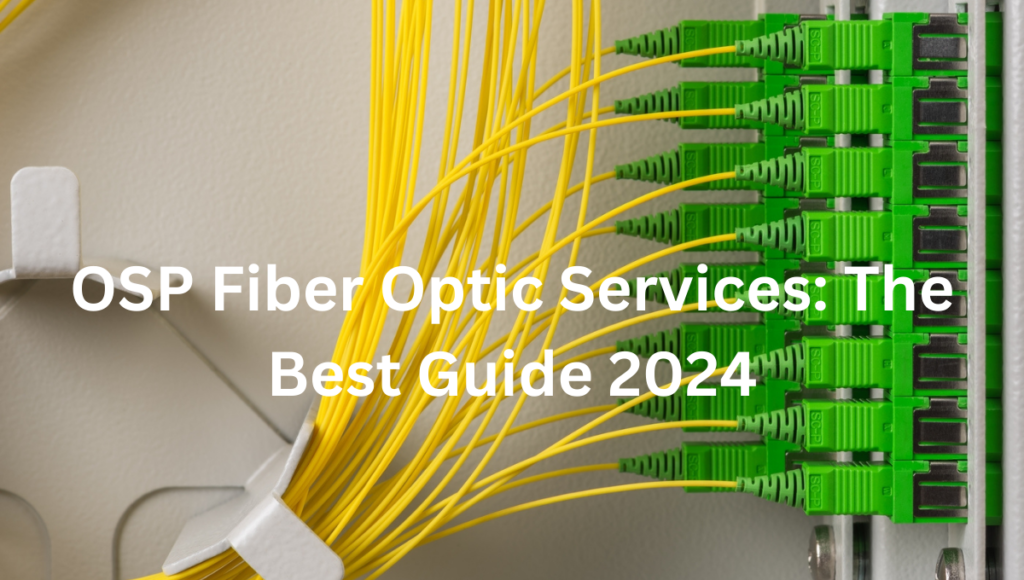
To ensure seamless connectivity and efficient management of fiber optic cables, patch panels are installed at both ends of the link. This equipment is essential for the installation of the plant project. These panels act as central points in the cable plant project where individual fibers and equipment can be connected or patched during the installation.
Final Testing and Commissioning
Once the fiber optic cable connections and patch panels for the cable plant installation are made, a final round of testing is performed to ensure that light signals can pass through without any issues using the appropriate equipment. This step ensures the reliable installation of equipment in the cable plant, guaranteeing that end users will receive reliable phone and internet services once the project is activated.
By following this step-by-step guide, OSP fiber optic installations for the cable plant can be efficiently carried out by contractors using the appropriate equipment under the supervision of project managers. This ensures minimal loss during the installation process. Proper planning, documentation, and adherence to industry standards are crucial for a successful installation process of equipment and cable plants. These steps help prevent loss and ensure a smooth installation.
OSP Fiber Optic Maintenance and Troubleshooting
Regular maintenance is important for keeping [OSP fiber optic services](https://www.thefoa.org/) running smoothly. This involves inspecting cables, cleaning connectors, and monitoring signal quality to prevent any loss. Troubleshooting with OTDR testing helps find faults in the cables, like breaks or bends, so they can be fixed. Having a well-equipped restoration kit is important for quick resolution when problems arise. Proper training is also necessary for successful installation, maintenance, and troubleshooting. By addressing these needs, providers can offer reliable services and keep customers happy.
Benefits of OSP Fiber Optic Networks for Enhanced Connectivity
OSP fiber optic networks are revolutionizing the way we connect and communicate with their efficient cable plant installation. With their high bandwidth capacity, cable plant networks enable faster data transmission, supporting a wide range of applications. The installation of these networks is crucial for efficient connectivity. Whether you’re streaming videos, playing online games, or conducting business transactions, OSP fiber networks deliver a seamless user experience with minimal lag. The installation of the OSP cable plant ensures optimal performance.
OSP fiber optic networks, also called cable plants, have many benefits. They are reliable and have low latency for uninterrupted communication. They are secure against interference, good for industries like healthcare and finance. They can transmit data over long distances without losing quality, good for connecting faraway places. Lastly, they can handle more data as technology improves. Overall, OSP fiber optic networks are a stable and efficient choice for different industries and connectivity needs.
OSP Fiber Optic Cable Types and Splicing Techniques
In outside plant (OSP) fiber optic networks, different types of cables and splicing techniques are used to ensure optimal performance and durability. Let’s take a closer look at the various types of OSP fiber optic cable for plant installations and the splicing techniques available.
Types of OSP Fiber Optic Cables
- Loose-tube plant cables are designed for installations in harsh environments where protection against moisture and physical damage to the plant is crucial. They feature multiple fibers within a protective tube, allowing for flexibility and resistance to external factors in the cable plant.
- Tight-buffered: Ideal for indoor or controlled environments, these cables have individual fibers tightly enclosed within a protective buffer material. They offer enhanced protection against mechanical stress in the cable plant while maintaining high signal quality.
- Armored: As the name suggests, armored cables have an additional layer of armor that provides extra protection against rodents, crushing forces, and other potential hazards. Cable plants are commonly used in areas prone to physical damage or where added security is required.
- Aerial: Designed specifically for above-ground installations such as utility poles or suspension wires, aerial cables are engineered to withstand environmental factors like wind, ice, and temperature variations.
Splicing Techniques
To join individual fibers together with minimal signal loss in OSP networks, two primary splicing techniques – cable plant – are commonly employed.
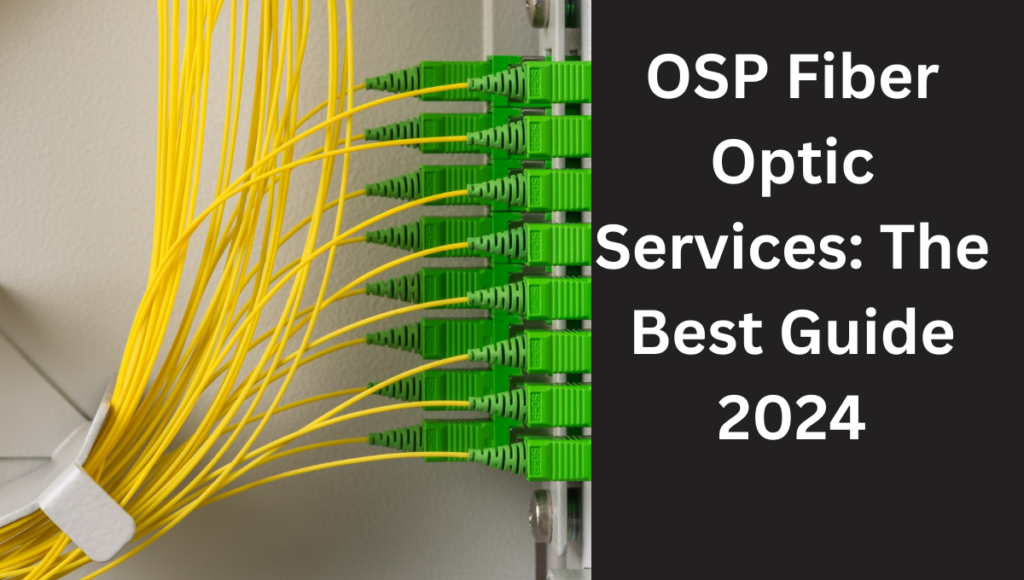
- Fusion Splicing: This technique involves using heat to fuse the ends of two fiber optic cables. A cable plant creates a permanent connection that offers low insertion loss and high reliability. The cable plant is designed to provide a reliable and efficient means of transmitting data. It ensures a secure and stable connection between devices, minimizing signal loss and maintaining high performance. With its low insertion loss and high reliability, the cable plant is an essential component of any network infrastructure. Fusion splicing is typically used for single-mode fibers or when low-loss connections are essential in the cable plant.
- Mechanical Splicing: Unlike fusion splicing, mechanical splicing utilizes specialized connectors to align and secure the fiber ends without heat fusion. This method is commonly used in cable plant installations. While it may introduce slightly higher insertion loss compared to fusion splices, the cable plant offers greater ease of installation and reusability.
By selecting the appropriate cable type based on installation environments and employing suitable splicing techniques, OSP fiber optic networks can ensure reliable and efficient communication over long distances.
Future Trends in OSP Fiber Optics and Conclusion
Congratulations! You now understand OSP fiber optics and cable plant, from basics to installation, maintenance, and benefits. The future of OSP fiber optics is promising with technology advancements for faster and more reliable networks. As demand for high-speed internet and data transmission grows, OSP fiber optics will play a crucial role in meeting these needs. What’s next? Take action and embrace the opportunities of OSP fiber optics and cable. Whether you want to improve your home network or stay competitive in business, consider using OSP fiber optic cables. With lightning-fast speeds, low latency, and exceptional reliability, OSP fiber optics can revolutionize your connectivity experience for both home and business use.
FAQs about OSP Fiber Optics
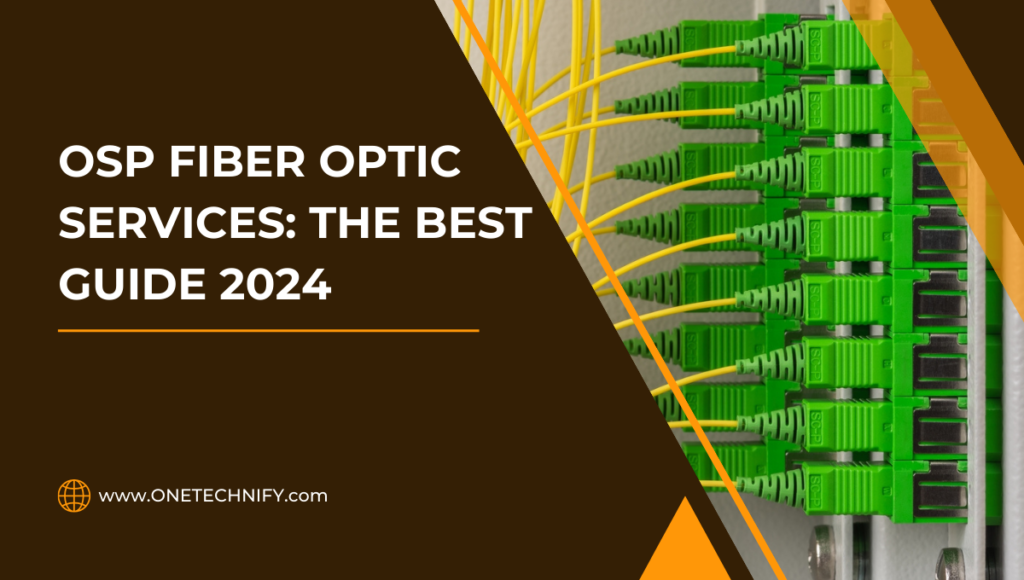
What are the advantages of using OSP fiber optic cables over traditional copper cables?
Fiber optic cables are better than copper cables. They can transmit data faster because they have more bandwidth. They don’t get messed up by electricity or radio waves. They are also smaller and lighter, so they are easier to put in and use.
Can I install OSP fiber optic cables myself?
While individuals with technical knowledge can install OSP fiber optic cables themselves, it is recommended to hire professionals who specialize in this field. Proper installation techniques for cable are crucial for optimal performance and longevity of the network. Professionals have the expertise and equipment necessary for precise cable installation while adhering to industry standards.
How long do OSP fiber optic cables last?
When OSP fiber optic cables are set up and taken care of, they can last for 25 years or longer. They are built to handle tough weather like extreme heat, moisture, and UV rays. If you check on them regularly and do maintenance, you can catch any problems early and make sure the cables last a long time.
Can OSP fiber optic networks be upgraded in the future?
One good thing about OSP fiber optic networks is that they can be easily upgraded or expanded without causing much trouble. This means you can keep up with the changes in technology and make sure your cables are always up to date.
Is OSP fiber optics suitable for both residential and commercial use?
OSP fiber optics cable is awesome for homes and businesses. It gives you faster internet at home and reliable connectivity for your business. You can stream HD content at home or do data-heavy tasks at the office. It’s the best choice for connecting cables and transmitting data. OSP fiber optics works great for homes, offices, and data centers. You’ll love streaming HD and doing data tasks with it.
Remember, embracing the power of OSP fiber optics and cable can unlock a world of possibilities for you or your business. Don’t hesitate to explore this transformative technology today!



